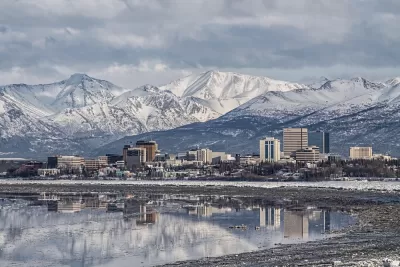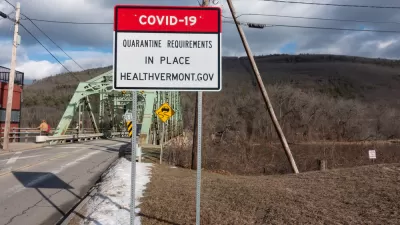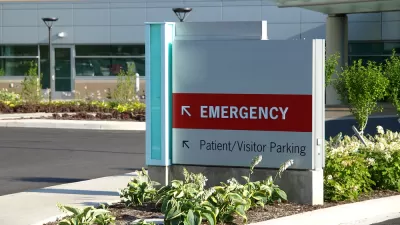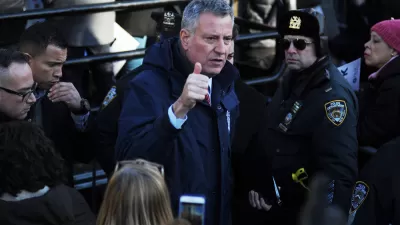Daily new COVID cases per capita in Alaska are the nation's highest. The crisis standards enable overwhelmed hospitals to ration care. Gov. Mike Dunleavy recognized the crisis yet saw no need to take steps to reduce coronavirus transmission.

Two of the three COVID health metrics in the U.S. are improving. The daily average of new cases are down 18% during the last two weeks to just below 120,000 on Sept. 26, according to The New York Times coronavirus database. Hospitalizations have dropped by 15% to 86,000, but daily new deaths, a lagging indicator, are up 23% to over 2,000.
However, daily new cases in 14 states and the District of Columbia have increased by double digits in the last two weeks, led by Wisconsin (72%), Alaska (62%), and Montana (50%). The hospital crisis in Alaska is particularly severe, reported Daniel E. Slotnik, Eduardo Medina and Mike Baker of The New York Times on Sept. 24.
On Wednesday, the state said it had activated "crisis standards of care," giving hospitals legal protections for triage decisions that force them to give some patients substandard care.
The declaration of the activation of the crisis standards was buried in a press release issued by the governor's office announcing that "hundreds of medical personnel are coming to Alaska to assist the State’s health care facilities:"
On Sept. 22, the Alaska Department of Health and Social Services (DHSS) enabled Crisis Standards of Care through the new addendum to the existing Public Health Emergency Order [pdf]. Commissioner of Health and Social Services Adam Crum said that while the addendum gives a health care framework for providers, providers will continue to make patient decisions according to their policies and available resources.
In fact, Crum appeared to downplay the significance in the press release of enabling hospitals to reject patients seeking their care, making it appear as merely a bureaucratic procedure as opposed to the recognition of an unprecedented crisis in the delivery of health care services requiring hospital personnel to make life-and-death decisions as to which patients to treat.
"Let me be clear: this is not a disaster declaration, nor a mandate, and does not require any new legislation. The goal of this addendum is to provide support and guidance to our state’s health care providers as they continue to care for Alaskans during these unprecedented times."
By contrast, the press releases issued by the Idaho Department of Health and Welfare announcing the activation of the crisis care standards for North Idaho on Sept. 6 and statewide on Sept. 16 recognize the gravity of what the health care personnel will be forced to do to best handle the influx of patients.
Delta surge
Like the southern states before it, Alaska is experiencing the most severe surge in the pandemic, surpassing the peaks in cases, hospitalizations and deaths recorded during the fall surge in December.
"As of Thursday, the state was averaging 125 new cases a day for every 100,000 people, more than any other in the nation, according to recent data trends collected by The New York Times," add Slotnick, Medina and Baker. "That figure has shot up by 46 percent in the last two weeks, and by more than twentyfold since early July."
The 7-day national average of daily new cases on Saturday (Sept. 25 ) was 36 cases per 100k people, according to the Times U.S. database. In Alaska, it was 143 per 100k. The next highest was Wyoming with 96 per 100k, followed by West Virginia with 95 per 100k. On the Times global tracker, only Bermuda and Grenada had higher case incidence.
Jared Kosin, the head of the Alaska State Hospital and Nursing Home Association, called the surge “crippling” in an interview on Tuesday. He added that hospitals were full, and health care workers were emotionally depleted. Patients recently were kept waiting for care in their cars outside overwhelmed emergency rooms.
There is growing anxiety in outlying communities that depend on transferring seriously ill patients to hospitals in Anchorage, Mr. Kosin said. Transfers are getting harder to arrange and are often delayed, he said.
Excess mortality
Alaska's News Service reported on Sept. 21 on the outcomes when transfers are delayed and space is unavailable due to the excessive number of COVID patients.
Dr. Kristen Solana Walkinshaw told a group of Alaska reporters Monday that one person had died because the dialysis treatment they needed was not available, and that a rural cardiac patient died after Providence hospital couldn’t accept them and perform a cardiac procedure unavailable in the patient’s area.
Those two deaths, and the others that aren't reported by the press, are what the health community calls excess mortality due indirectly to the pandemic, another reason why the term, "pandemic of the unvaccinated" may be inappropriate, and illustrating why the pandemic is essentially a hospital crisis that can affect everyone needing care when transmission goes unchecked as it is in Alaska.
Not dire enough to warrant intervention
"Gov. Mike Dunleavy, a Republican, said that while hospitals were strained, he did not see a need to implement restrictions aimed at curbing transmission," add Slotnick, Medina and Baker. "Still, he encouraged people who had not yet received a vaccination to seriously consider it."
With only 50% of the population fully vaccinated, Alaska is almost 5% below the national average of 55%. Similarly, West Virginia and Wyoming have even lower levels fully vaccinated, 40% and 41%, respectively, the nation's lowest according to the Times tracker on Sept. 25.
But additional vaccinations, at this point, will do little to stem the state's fourth surge caused by the Delta variant due to the time needed to become fully vaccinated. Dunleavy should consider the advice offered his Democratic colleague, Gov. Gretchen Whitmer when she asked for more vaccines when Michigan was the nation's hotspot in April.
"The head of the Centers for Disease Control and Prevention justified the federal government’s decision not to funnel additional Covid-19 vaccines to Michigan as cases there surge, saying Monday it would be more effective for the state to impose restrictions and shut down again instead of waiting weeks for vaccines to take effect," wrote Alison Durkee for Forbes on April 12.
"It's ridiculous!"
Like Dunleavy, Gov. Brad Little of Idaho refused to impose restrictions to reduce viral spread when he activated the crisis care standards statewide almost a week earlier on Sept. 16. That didn't sit well with hospital officials in neighboring Washington state, reported the Times Seattle bureau chief, Mike Baker, on Sept. 13.
On the Washington side of the border, residents must wear masks when gathering indoors, students who are exposed to Covid face quarantine requirements, and many workers are under vaccination orders. On the Idaho side, none of those precautions are in place.
“It’s ridiculous,” said Cassie Sauer, the president of the Washington State Hospital Association. “If you have your health care system melting down, the idea that you would not immediately issue a mask mandate is just bizarre. They need to be doing everything they can possibly do.”
Death rate skyrockets
Finally, a reminder of the toll that COVID-19 is taking on the lives of Alaska's residents. The "new reported deaths by day" graph on the Times Alaska coronavirus database shows a vertical line on Sept. 24 indicating that the 7-day average had jumped from 2.9 deaths on Sept. 23 to 9 deaths the next day, far surpassing the prior peak of 4.7 on Dec. 14. Alaska Public Media explains what the Times usually refers to as an anomaly, though it isn't indicated on their graph.
The state of Alaska reported a new single-day record Friday of 1,735 COVID-19 cases among residents, along with 44 deaths over the past year that were newly linked to the coronavirus.
The new numbers are also likely to increase pressure on Republican Gov. Mike Dunleavy and Anchorage’s conservative mayor, Dave Bronson, who have both resisted calls to institute measures like mask mandates and business restrictions to help control the spread of the virus.
Let's hope.
Related in Planetizen:
- The Pandemic Crisis Is a Hospital Crisis, September 23, 2021
- Louisiana's Health Care System on Brink of Collapse, August 26, 2021
- Living (and Dying) with COVID: How Many Deaths are Acceptable? July 28, 2021
- California Hospitals Now Operating Under Contingency Care Guidelines, January 4, 2021
- COVID's Extensive 'Excess Mortality',October 25, 2020
Hat tips to Jonathan Wolfe and Amelia Nierenberg, editors of The New York Times Coronavirus Briefing newsletter.
FULL STORY: Hospitals in Alaska struggle to handle a worsening outbreak.

Study: Maui’s Plan to Convert Vacation Rentals to Long-Term Housing Could Cause Nearly $1 Billion Economic Loss
The plan would reduce visitor accommodation by 25,% resulting in 1,900 jobs lost.

North Texas Transit Leaders Tout Benefits of TOD for Growing Region
At a summit focused on transit-oriented development, policymakers discussed how North Texas’ expanded light rail system can serve as a tool for economic growth.

Using Old Oil and Gas Wells for Green Energy Storage
Penn State researchers have found that repurposing abandoned oil and gas wells for geothermal-assisted compressed-air energy storage can boost efficiency, reduce environmental risks, and support clean energy and job transitions.

Private Donations Propel Early Restoration of Palisades Playground
Los Angeles has secured over $1.3 million in private funding to restore the Pacific Palisades playground months ahead of schedule, creating a modern, accessible space that supports community healing after recent wildfires.

From Blight to Benefit: Early Results From California’s Equitable Cleanup Program
The Equitable Community Revitalization Grant (ECRG) program is reshaping brownfield redevelopment by prioritizing projects in low-income and environmental justice communities, emphasizing equity, transparency, and community benefits.

Planting Relief: Tackling Las Vegas Heat One Tree at a Time
Nevada Plants, a Las Vegas-based nonprofit, is combating the city’s extreme urban heat by giving away trees to residents in underserved neighborhoods, promoting shade, sustainability, and community health.
Urban Design for Planners 1: Software Tools
This six-course series explores essential urban design concepts using open source software and equips planners with the tools they need to participate fully in the urban design process.
Planning for Universal Design
Learn the tools for implementing Universal Design in planning regulations.
Ascent Environmental
Borough of Carlisle
Institute for Housing and Urban Development Studies (IHS)
City of Grandview
Harvard GSD Executive Education
Toledo-Lucas County Plan Commissions
Salt Lake City
NYU Wagner Graduate School of Public Service





























